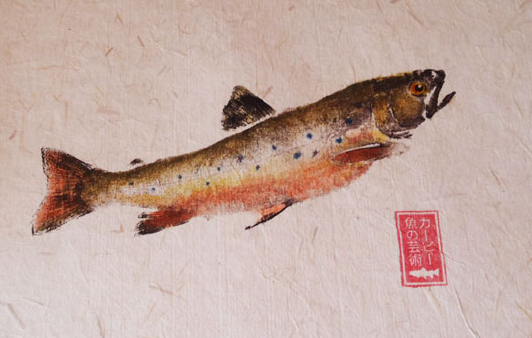When John Gierach contacted us expressing his interest in tenkara, I had no idea his interest in Japanese culture would extend so far beyond the type of fishing we were introducing here. In 2010 I had the pleasure of spending a couple of days at his home, where I learned that in college he enjoyed Japanese literature, not long after became interested in bonsai, and then even tried making his own gyotaku.
Recently I have been communicating with Kirby Wilson, a Canadian artist living in Lahti, Finland, who has mastered the technique and art of gyotaku. For those of you interested in elements of Japanese culture, especially elements of Japanese mountain culture and tenkara, I believe you'll enjoy learning about this centuries-old form of art.
From Kirby's site (freshcatchgyotaku.com):
"Gyotaku (gee-oh-tah-koo) is the Japanese art of making fish prints on delicate washi paper. This art form reproduces the exact features and characteristics of the actual fish. In Japanese, "gyo" translates to "fish" and "taku" translates to "stone rubbing" which refers to the technique of fish rubbing. Gyotaku began in Japan in the early 1800s as a means to measure and record a commercial fisherman's catch.
Today gyotaku has evolved into an art form. I start by inking the freshly caught fish with a nontoxic, water-soluble ink, then the Japanese washi paper is placed on the fish and is hand-rubbed. After removal of the paper, the eye is hand-painted bringing the gyotaku to life. I hand color many of my monotone rubbings but also do rubbings using colored ink resulting in a scale-by-scale likeness of the fish. My "chop" or hanko with my signature are added to complete the artwork. Each print is a one-of-a-kind-original
Today, Gyotaku is an alternative to taxidermy and mounting fish, and has become a recognized form of fine art. It's also agreat way for me to share memories of fun days on the water with friends."
Who knows? Maybe some tenkara anglers back in the day may have even indulged in this art form. The commercial fisherman referred to above are most likely ocean fisherman and those living in the townships. Although we'll never know whose hands pressed the fish agains the paper there are some pretty old gyotaku in the mountains of Japan.
